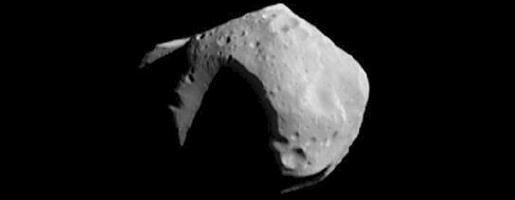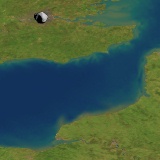 |
|||
|
The best image of Mathilde obtained by the NEAR spacecraft
shows the cratered surface.
|
|||
| ASTEROID MATHILDE | |||
| The asteroid 253 Mathilde was discovered by the Austrian astronomer Johann Palisa in 1885. Palisa had discovered 243 Ida the previous year. Mathilde was eventually named in honour of the wife of the Paris Observatory's vice-director, Moritz Loewy. | |||
| Orbit | |||
| Mathilde is located in the main asteroid belt. Its orbit is inclined to the plane of the ecliptic by 6.7o and follows an elliptical path about the Sun. Its perihelion or closest approach to the Sun is 304 million kilometres. Its aphelion distance from the Sun is 487 million kilometres. | |||
 Mathilde's orbit. |
|||
| Ground based observations determined Mathilde's long rotational period. Mathilde rotates extremely slowly, taking 17.4 days. Asteroid 951 Gaspra takes just over 7 hours to complete a rotation, and 243 Ida takes only 4 hours 38 minutes. Mathilde's slow spin is probably the result of a collision with another body. A few other asteroids have extremely long rotation periods, like 1220 Clocus, and 288 Glauke which takes 48 days. | |||
| Physical properties | |||
| Mathilde measures 70 kilometres x 50 kilometres. Though not particularly large, it is comparable in size to many small moons. Mathilde has a low mass and a correspondingly low density. Mathilde has a density of only 1400 kg m-3 and is thought to comprise very porous material. Some researchers suggest that it has been able to withstand a large number of big impacts because it has a sponge-like structure. | |||
 Comparison between Earth and Mathilde. |
|||
| Surface | |||
| Mathilde was approached by NASA's Near Earth Asteroid Rendezvous (NEAR) spacecraft which made a flyby of the asteroid in June 1997 on its way to 433 Eros, its main objective. Mathilde is the largest asteroid visited by spacecraft so far, twice the size of 243 Ida. | |||
 The best image of Mathilde obtained by the NEAR spacecraft shows the cratered surface. |
|||
| The NEAR spacecraft returned nearly 150 close-up images of Mathilde's surface during its closest approach, at about 1200 kilometres. In the best images, features as small as 400 metres can be picked out. It obtained many more lower resolution pictures as it began its approach and as it left the asteroid behind. Because of Mathilde's slow rotation, NEAR was only able to image one side. The resulting pictures show about 60% of the surface, revealing a heavily cratered landscape. | |||
| Though Mathilde is not very reflective, the NEAR spacecraft was able to obtain good pictures in a variety of colour wavelengths using a multispectral camera. | |||
| The surface of Mathilde is very dark. It has an albedo of 0.036 which means that it reflects just 3.6% of the sunlight which reaches its surface. This makes Mathilde darker than charcoal. Mathilde is in fact one of the darkest objects in the Solar System. Mathilde appears colourless in visible light. There is little tonal variation which might otherwise suggest that it is composed of different types of material. The craters, for example, have not excavated material which appears any different from that found on the surface. Mathilde is homogeneous throughout and may be a remnant of the early Solar System. | |||
| Observations made in 1995 identified Mathilde as a C-type asteroid. C-types account for three quarters of the total asteroid population; they are dark and have low albedos. C-type asteroids are analogous to carbonaceous chondrite meteorites. | |||
| Chondrites contain chondrules which are pellet-like globules of silicate minerals embedded in the rock. They are thought to have formed from primitive or unaltered solar nebula material. | |||
 Asteroid Mathilde from 1,200 kilometres. |
|||
| There is an unusually high number of large craters, considering Mathilde's modest dimensions. There are 5 craters with diametres greater then 20 kilometres. The central crater is about 30 kilometres in diameter and is estimated to be about 10 kilometres deep. | |||
| Mathilde's crater rims, viewed obliquely, give Mathilde a very angular or blocky appearance. The form of Mathilde's craters has baffled researchers, as the rim-crests of the large early craters have survived disruption by the more recent ones. This is also ascribed to Mathilde's porous nature. The number of big craters, for a body its size, suggests that it has had a particularly turbulent history. Stresses in Mathilde have formed fractures which have caused some crater rims to have straight sections. There are also faint linear markings on the surface, but it is difficult to determine how these were formed, because the details of their shape are not known and it is hard to see how they relate to other features. | |||
 NEAR spacecraft image of Mathilde's crater ridges. |
|||
|
|
|||